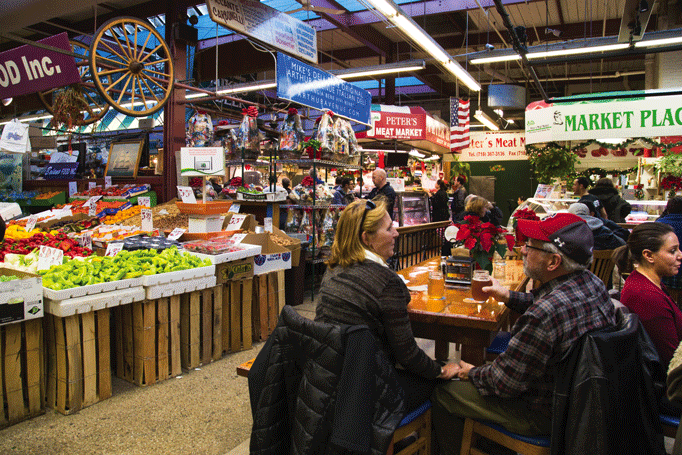
From sandwiches to steak, lobster and sushi, many grocery stores now offer experiences of food and dining that once were considered exclusively the purview of restaurants. Today’s “grocerants,” as the industry calls them, are a far cry from the store food counter of yesteryear. They may include coffee bars or even sell alcohol, often showcasing locally brewed beers and regional vintners. More than a source for a quick bite, many of these grocery store eateries are social destinations within the community.
“We’re moving into a new era where many of the grocers are putting these things in, and they’re exciting, vibrant and active,” said Andrew Couch, a managing director at DJM Real Estate, a division of Gordon Brothers Group. “They’re becoming a gathering space, and they’re trendy.” Couch testifies that the best lunchtime sandwich he ever ate came off the menu at a Pub by Wegmans in upstate New York.
Wegmans Food Markets runs a variety of restaurant concepts within its 89 stores, including 10 pubs, several burger bars and an Italian restaurant. The company also operates a freestanding restaurant in Pittsford, N.Y., called Next Door by Wegmans.
Whole Foods Market offers bars and restaurants in many of its stores, often packaging several concepts into one location. HEB, based in San Antonio, has five restaurants, each with a menu tailored to the local market. Among others, Hy-Vee is opening several of its Market Grille full-service restaurants this year, and Giant Food Stores is adding Beer Garden & Eatery spots in its stores.
“People make an intentional trip to go to these things, and it’s an event and an experience, as opposed to just filling your stomach,” Couch said. The difficulty of finding a location that fits the size and demographics requirements for both a grocery store and a restaurant will probably restrict the grocerant phenomenon to a small fraction of U.S. stores, Couch speculates. “You almost need a very large grocery store to have these types of offerings,” he said, “but very large grocery stores are hard to locate near high-density population bases that have a lot of high-income households, or singles with no children, and those are the people that dine out.”
Grocerants are a twist on decades of adaptation on the part of retailers to the ways consumers buy foodstuffs, according to Bill Bishop, chief architect at Chicago-based retail consultant firm Brick Meets Click. “For as much as 20 years, supermarkets have strived to be in the prepared-foods, ready-to-eat, ready-to-cook business,” Bishop said. “It came from not seeing the basic ingredients themselves sell from their shelves as much as they used to. Grocerants emerged when people began to think that the real answer is a solid hybrid of what they do in retail and what they do in restaurants.”
Readymade meals and, more recently, on-site dining not only capture additional sales at the grocery store, but also have the potential to generate more-frequent customer visits. The strategy only works, however, if the grocer makes a desirable product in a setting that people want to visit. “You wouldn’t want to do it if you didn’t have the skills to do it well,” Bishop said. A grocerant is a risky venture for a store just breaking into prepared foods, but grocers already producing a popular assortment of ready-to-eat meals have much of the required infrastructure and personnel already in place for restaurant services. Bishop advises those retailers that are intent on on-site dining to start out by offering grab-and-go packaged foods first, and then ways to order online for pickup. Once that gains a following, the store can add seating and develop the space into a dining destination.
As a retail strategy, in-store dining may only work for a subset of grocery stores. But when viewed as the pairing of retail with experiences customers will seek out frequently, the idea has applications across a larger retail spectrum, contends Bishop. “Consumption of food is a way to drive traffic,” he said, “and once you have the customers there, every good merchant will tell you they can sell something to those customers.”
Chef Mario Batali’s Eataly stores, for example, blur the lines between restaurant, retail and entertainment. “They’re combining attractions and opportunities to generate sales,” Bishop said. “The big deal is the interaction between food, retail, and trip-generation.”